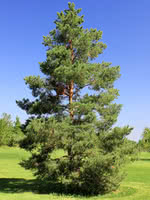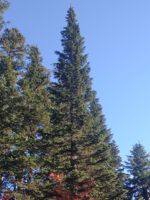Mon-Fri 9am - 5pm Mountain time
Scots Pine (Scotch Pine) vs Pacific Silver Fir
Pinus sylvestris
Abies amabilis
CUSTOM GROW
Scots Pine is a hardy, adaptable evergreen. This large tree has an oval crown and distinctively orange bark when mature. Scots Pine prefers dry to average moisture levels with very well-drained soil.
It is the most common pine tree used in shelterbelts and windbreaks. Scots Pine is also occasionally used as a Christmas tree variety.
Pacific Silver Fir is a tall evergreen tree native to the Pacific Northwest. It has two-toned needles, dark green on top with silvery undersides, giving the tree a distinctive appearance. The straight trunk and dense, symmetrical crown make it a striking forest species.
Pacific Silver Fir thrives in cool, moist, high-elevation forests. It is the most shade-tolerant of the true firs and among the most shade-tolerant of all native conifers, allowing it to grow beneath the canopy of older trees. It provides cover for wildlife and food from its seeds, while also contributing to the structure and stability of mountain forest ecosystems.
The species is harvested for timber and pulp and has been used ornamentally in some plantings. Well-suited for ecological restoration, naturalization, and habitat projects where native conifers are needed. Pacific Silver Fir lives up to its Latin name, amabilis, meaning “lovely,” in recognition of its striking appearance.
Scots Pine (Scotch Pine) Quick Facts
Pacific Silver Fir Quick Facts
In row spacing: 3 - 4 m (10 - 12 ft)

